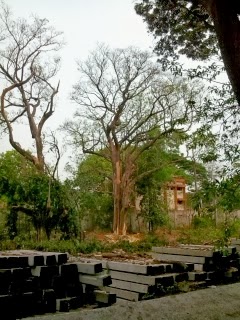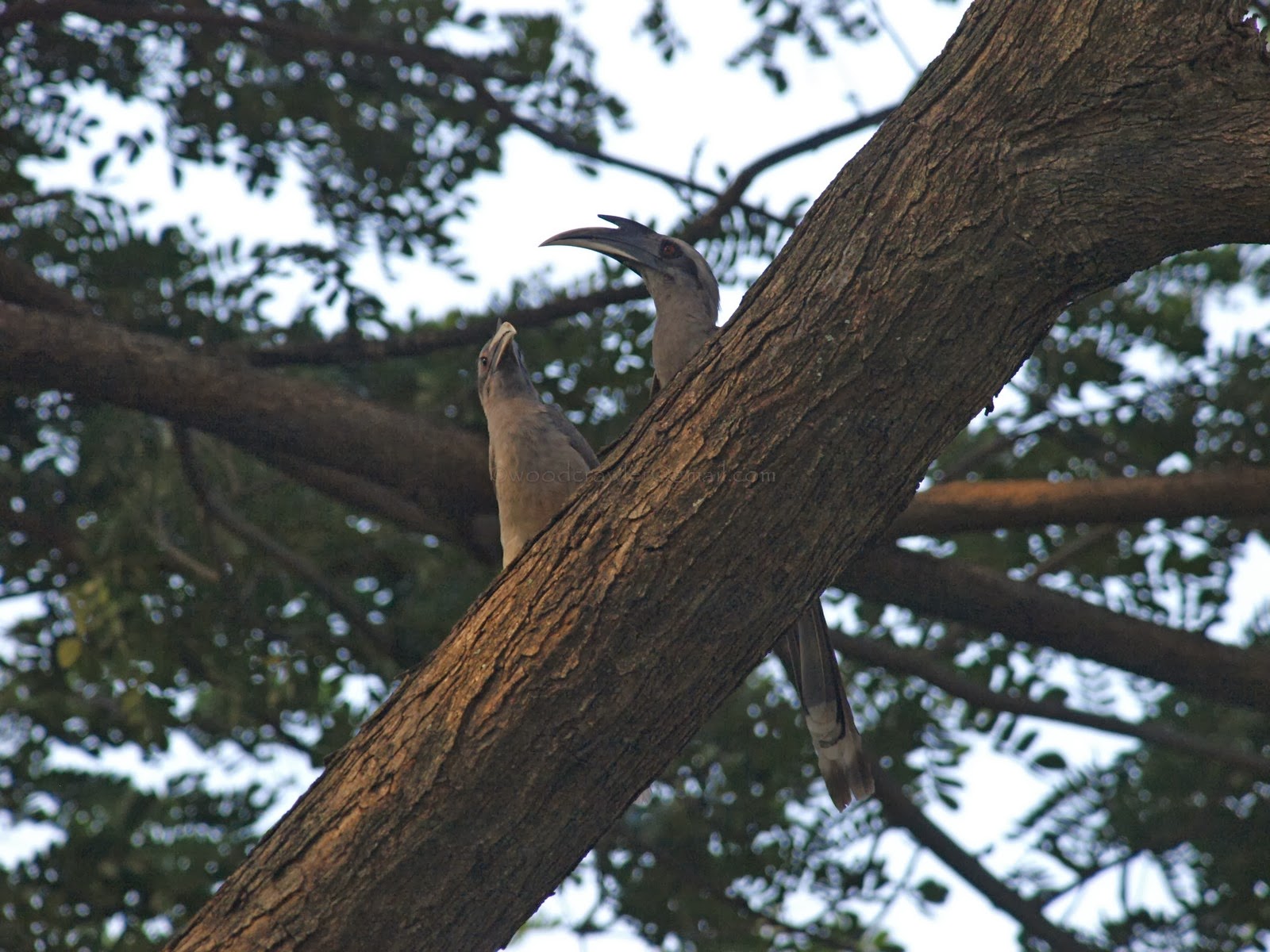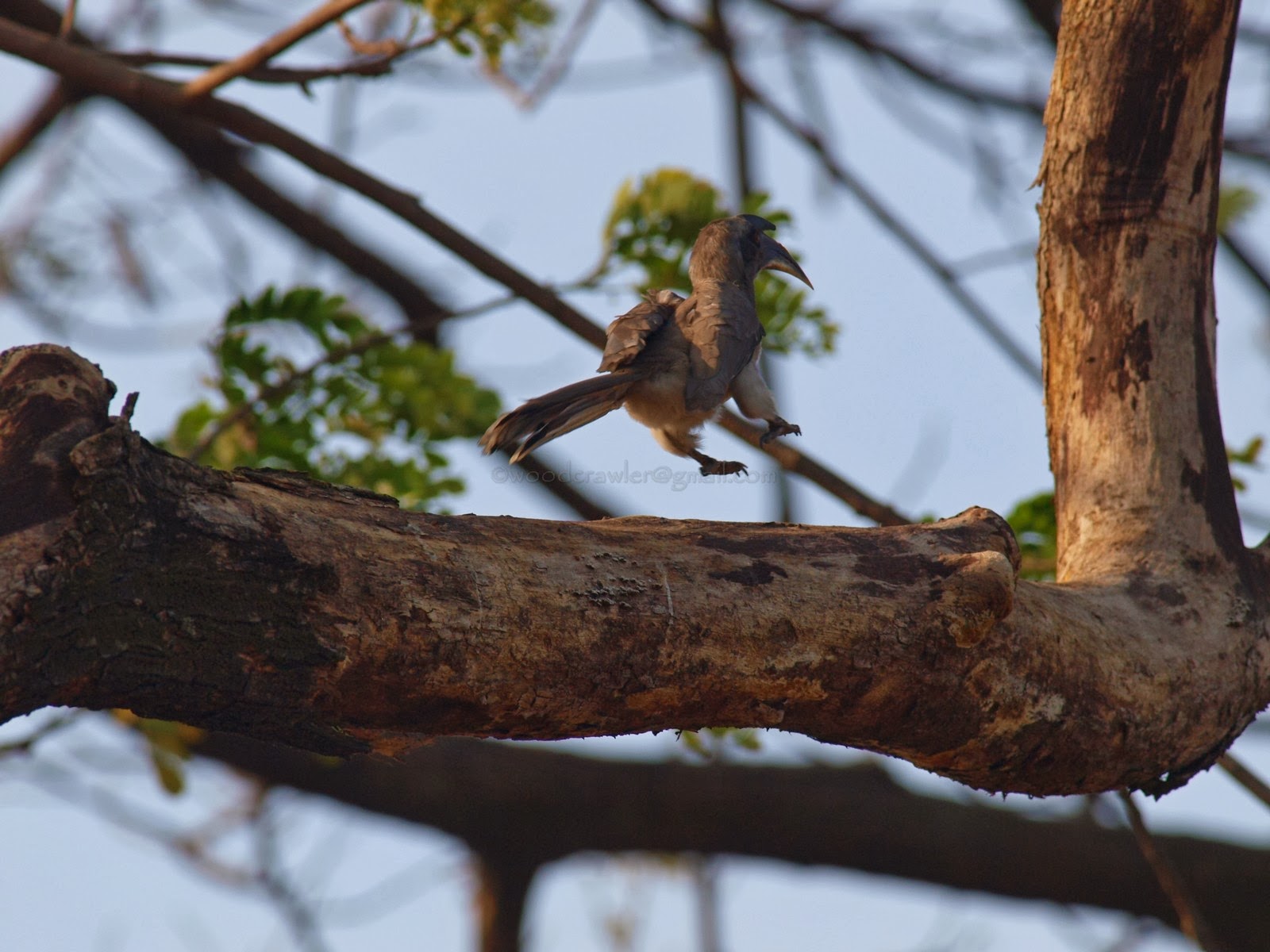Urbanization has its evils. Destruction of patches of green that causes habitat loss for creatures living in it and displaces them. But, it also proves that Nature can take over an heal the damages wrought by man. This is the tale of one such green patch in Palakkad, my hometown in Kerala, and its inhabitants. The main characters in this tale are the Indian grey hornbills, a very common bird seen in our urban areas. They are true survivors and they pair up for life. This is their story.
In the heart of my town, Palakkad there is a bit of land on which stands the Palakkad town railway station. In the old days this was the junction for the meter gauge track from the Palani-Madurai route. There used to be a depot of the Indian Oil Corporation Corporation (IOCL) on the western side of the tracks and we had, and still have, a retail outlet of IOC on the eastern side opposite the Municipal bus stand.
 |
| The green belt in the middle is the railway land. Click the link above to go to Google Maps |
The railway's yard already had huge trees in it's premises. With the stoppage of rail traffic the goods yard was shut down and human activity came to a standstill. Once the IOCL depot too was dismantled the rear approach to the railway station became an abandoned area. The only activity now is after 9 PM when passengers bound for Thiruvanathapuram come directly to the platform from that side. The IOCL depot is a wild unkempt area now with anti-social elements prowling around within its crumbling walls and poor people using it as a large open air lavatory! The trees grew with gay abandon, till some were cut recently for widening of the tracks. (The photos were clicked with my cellphone camera)
 |
 | ||||
 |
 |
| This tree still stands and our story plays out on it |
 |
This tree has a hole in a strategic location some 30 feet up on its trunk. For any self respecting bird that would be the hole to which he would bring his mate to! It has been a prized nesting location for a generation of Indian grey hornbills. Come the breeding season, they make a beeline for it and there is serious competition. Of course, only one pair will have the privilege of occupying that cozy little hole!
Of course, such a strategically placed tree hole would have attracted the attention of 'encroachers' when the hornbills were away. This hole was no exception. I noticed a pair of mynas flying around agitatedly. Obviously they had occupied it and now they were about to get 'evicted'!
When the season arrived, as usual, the annual 'house hunting' started in earnest. It was in late October that I noticed the first pair. They were the earliest to stake claim and inspection went on in earnest. I'm not sure if they are the same pair that nested there last year. Technically this is not the breeding season for the Indian grey hornbill. That comes later between March to June. However, courtship, pair feeding, mating and nest searching starts in November or December.
30th October, 2013
For the next few days they were the main pair, identifiable by a single white tipped black feather on the right side of the male's tail.
8th November, 2013
Then there was a flow of 'couples' to inspect the new 'apartments' on this tree. I counted nine pairs on one morning. They were sitting on different branches of the tree and would patiently wait for one pair to finish their inspection before moving in for their turn.
 |
| Pair 2 |
 |
| Pair 3 |
 |
| "Ok. The doorway is fine...." |
 |
| ".......and the inside looks cozy, except for those darned myna's poo!" |
 |
| Pair 4 |
 |
| Pair 5 |
While they waited, some of them would go around looking for other tree holes with potential to be their next home.
 |
| "No hole here." |
 |
| "Hmmm.....this place has potential." |
 |
| "Hey! There is a hole here!" |
 |
| "Anybody home?" |
 |
| "Darn it! My beak barely fits!" |
 |
| Pair 6 |
 |
| "Nice hole here baby!" |
 |
| ".....and a nice view too." |
 |
| Pair 7 |
Eventually it dwindled down to two pairs. The second pair has found another hole on a branch on the same tree but I'm unable to get a clear view because photography is not allowed in railway land! I have one distinct advantage though, my retail outlet lies adjacent to this green patch so I have an unhindered view of the tree and the activity that goes on around it.
Every year the pair that got the right for this tree hole would occupy it for the rest of the season. I have seen the nesting pair go in and out setting it up for living but the mynas too were not giving up. Every opportunity they got they'd also get inside and stake claim.
 |
| "Ok! They've gone!" |
 |
| "Mine!Mine!Myne!....Myna's!" |
Over the last few weeks this drama is played out every morning. I'm not sure who gets to occupy the hole at night. Every morning the main protagonists are always in action. When the hornbills are around the mynas keep a safe distance. Perhaps they are aware that a vicious knock with that huge beak could be fatal. Once the hornbills go on their foraging flights in the morning the mynas scamper back trying to establish their claim. I'm not sure how long they can hold out but they are not giving up just yet.
31st January, 2014
It seems that the first pair have agreed that this hole was where they were going to start their family. Every morning they would do some cleaning despite the mynas raising a ruckus around their heads.
 |
| Even if the female left the vicinity of the hole the male would hang around a little longer. |
 |
| Then he too would move off after her..... |
 |
| ...hopping and flying in short spurts.. |
 |
| ...to bask in the morning's sunshine. |
The hornbills didn't seem unduly concerned about the mynas. Maybe they knew that when push comes to shove the mynas wouldn't stand a chance. They were more worried about other birds in the area, the black kites.
The male was giving looks at the kite feeding above it. It seemed more worried about the kites than the mynas looking to occupy their nesting hole.
The initial hesitation passed and it seemed to make up its mind that the kite was no threat to his mate. After all it had a very nice meal to finish.
The mynas were a different kettle of fish. They were more hawk like in their attitude. Hanging around for the opportunity to get back their hole.
The mynas are also probably in their breeding mood and like the hornbills, a myna pair is mated for life. I read somewhere that mynas are messy so the hornbills can be expected to have a hard time cleaning up!
Seeing the mynas hanging around, the male flew down and stuck about the hole for a while.
Eventually both of them settled on a branch nearby, making sure the mynas did not get back into the hole.
It is going to be long summer for both the pairs. Who will eventually retain this prime piece of real estate remains to be seen. My bet is on the hornbills. Not because they are bigger and have a formidable looking bill but also because once the female gets in to lay her eggs, she gets sealed in for the rest of the incubation period and while the chicks are in their early days.
As for the second pair on this tree. They were a very contented looking couple. They had a nest on another branch which was away from prying eyes and my camera's lens. I could just about see them go in and out occasionally
.
A nest that is already setup is a catalyst for romance. It was evidenced by their courtship on the branches. She had a morsel in her bill, and was offering it to him.
He would take it in his bill gently......

.... then return it to her without swallowing it.
Sometimes he'd take it again, chomp on it.....
......hold on for a few seconds.....
....before returning it to her lovingly again! I thought romancing was old fashioned! After all romance nowdays, is confined to social networking sites and is usually very brief and eminently forgettable! Paired for life seems very strange term as far as us humans are concerned. Perhaps we can take a leaf out of the hornbill's life story.
These two pairs will be under my constant surveillance. I can't wait for the females to get walled in. I'm only worried the mynas will try to break the wall even as the first hornbill pair starts building it. It is a story that is building up. We have another five months to go for it to play out to its end.
5th February, 2014
Things have been happening at the Nesting Tree.
The Pair No: 1 still continues their war with the mynas and they are still struggling to assert their claim on the best hole in the tree.
Meanwhile Pair No: 2 have no such problems. They are busy with their courtship and house cleaning. I hope to get a closer access to their hole soon. It also means that the Trilogy is going to have more sequels than I have planned.
Watch this space closely

























1 comment:
What a lovely story that's unfolding...waiting to see what happens next!!!
Post a Comment